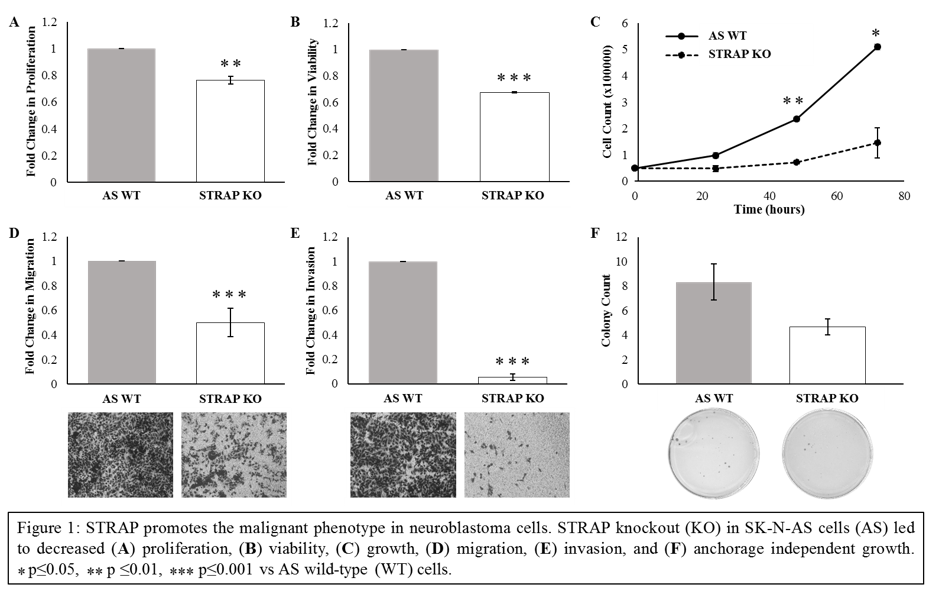L. Bownes1, A. Williams1, R. Marayati1, C. Quinn1, L. Stafman1, J. Stewart1, P. Datta2, J. Easlick3, E. Beierle1 1University Of Alabama at Birmingham,Division Of Pediatric Surgery,Birmingham, AL, USA 2University Of Alabama at Birmingham,Division Of Hematology/Oncology,Birmingham, AL, USA 3University Of Alabama at Birmingham,Division Of Transplantation,Birmingham, AL, USA
Introduction: Serine-threonine kinase receptor associated protein (STRAP) is upregulated in several malignancies and plays an important role in tumor growth and metastasis. The role of STRAP in pediatric malignancies and specifically in neuroblastoma (NB) has not been explored. We sought to determine whether STRAP functions to promote the malignant phenotype in NB.
Methods: CRISPR-Cas9 gene editing was utilized to establish stable genetic knockout (KO) of Strap in the human NB cell line SK-N-AS (AS). Immunoblotting confirmed STRAP KO. Growth curves for STRAP wild type (WT) and KO cells were documented at 24, 48, and 72 hours and cell survival and proliferation were compared using alamarBlue and CellTiter96 assays, respectively. Differences in cell motility were assessed using modified Boyden chamber assays. Anchorage independent growth was evaluated using soft agar assay. To investigate the role of STRAP in NB tumorigenesis in vivo, 1.8×106 WT or KO cells were injected into flanks of 6-week old athymic nude mice. Tumor volumes were measured with calipers three times per week. Splenic injections of WT and KO cells followed by splenectomy were performed to explore an in vivo model of NB metastasis cells. Liver ultrasound was used to quantify liver metastasis.
Results: Cell proliferation and survival were significantly decreased in the KO cells by 23% (p=0.002) and 32% (p=0.0001), respectively (Figure 1 A, B). Cell growth was also significantly decreased in the KO cells at 48 (p=0.004) and 72 (p=0.02) hours (Figure 1 C). STRAP KO cells showed significantly decreased migration (p<0.0001, Figure 1 D) and invasion (p<0.0001, Figure 1 E) compared to WT cells, and formed fewer colonies in anchorage independent growth conditions (p=0.09, Figure 1 F). In vivo, there was a decrease in average tumor volumes as well as relative tumor growth between mice injected with WT and KO cells. The metastatic model also demonstrated a trend toward decreased number (5 vs. 8) and average volume (26.7 vs. 65.4 cm3, p=0.1) of liver metastases in mice injected with KO compared to WT cells.
Conclusion: STRAP KO in NB cells led to decreased cell growth, survival, proliferation, and motility in vitro, as well as a trend toward decreased tumor volume and metastatic burden in vivo. These novel findings demonstrated that STRAP plays a role in promoting the malignant phenotype in NB and warrants further investigation as a potential therapeutic target in NB.
